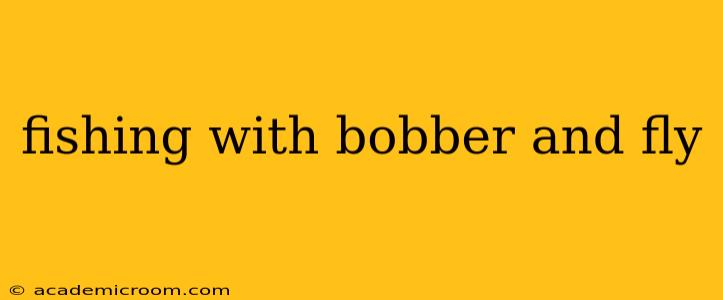Fishing with a bobber and fly is a versatile technique effective for catching a variety of fish species, particularly in calmer waters. This method combines the visual appeal of a dry fly with the controlled presentation offered by a bobber. Whether you're targeting trout in a stream or panfish in a pond, understanding the nuances of this technique can significantly increase your success. This guide will delve into the specifics, helping you master this exciting fishing method.
What is Bobber Fishing with a Fly?
Bobber fishing with a fly involves using a bobber (also called a float) to suspend a fly at a specific depth in the water column. The bobber signals strikes by dipping or disappearing beneath the surface. This technique allows for precise fly presentation, particularly useful in targeting fish holding at specific depths or in areas with obstacles. Unlike traditional bobber fishing with bait, using a fly offers a more natural and less intrusive presentation.
What are the advantages of using a bobber with a fly?
This method offers several key advantages:
- Increased Accuracy: You can precisely target specific areas and depths where fish are likely to be holding.
- Improved Presentation: The bobber keeps your fly suspended naturally, mimicking a drifting insect or other natural food source.
- Enhanced Visibility: The bobber makes it easy to detect even subtle strikes, particularly in low-light conditions.
- Versatility: Suitable for various fish species and water conditions, making it a truly adaptable technique.
- Ideal for beginners: The visual cues provided by the bobber make this a great method for anglers learning to fish with flies.
What type of bobber should I use for fly fishing?
Choosing the right bobber is crucial. Consider these factors:
- Water Conditions: In calm water, a smaller, more sensitive bobber is generally preferred. For windy or swift currents, you'll need a larger, more buoyant bobber to keep your fly in the strike zone.
- Fly Size and Weight: A heavier fly may require a larger bobber to keep it suspended properly. Match the bobber to the weight of your fly for optimal performance.
- Fishing Depth: The length of your leader and the depth of the water will dictate the type and size of bobber you choose. Consider using a slip bobber which allows for adjusting the fishing depth.
What kind of flies work best with a bobber?
Many flies can be effectively fished with a bobber, but some are better suited than others:
- Dry Flies: These imitate insects floating on the surface and work well when fished just beneath the surface tension.
- Small nymphs and emergers: These imitate insects in their immature stages and are effective fished at various depths below the surface.
- Wet flies: While typically fished without a bobber, some wet flies can be effectively employed with a bobber, particularly in shallower water.
How do I rig a bobber and fly?
The basic setup is straightforward:
- Choose your line: Use a fly line appropriate for your rod and the conditions.
- Attach the bobber: Slide the bobber onto your main line. The distance between the bobber and the fly will depend on the fishing depth. For a slip bobber, you'll need a stop knot above the bobber and a swivel below.
- Add a swivel (optional but recommended): This will prevent line twist.
- Tie on your leader: This should be a suitable length for your chosen depth and fly.
- Attach your fly: Tie your chosen fly to the end of the leader.
How do I fish with a bobber and fly?
- Cast your line: Cast upstream or across the current, allowing the bobber to drift naturally.
- Maintain line control: Keep your line taut to feel strikes and set the hook quickly.
- Watch the bobber: Observe closely for any indication of a strike – a dip, a sudden disappearance, or even a change in the bobber's rhythm.
- Set the hook: Once you see a strike, set the hook firmly.
What fish can I catch with a bobber and fly?
This technique is effective for various fish species including:
- Trout: Brown trout, rainbow trout, brook trout.
- Panfish: Bluegill, sunfish, crappie.
- Bass: Smallmouth and largemouth bass (in certain situations).
What are some common mistakes to avoid when bobber fishing with a fly?
- Using the wrong bobber: Selecting a bobber that’s too large or too small for the conditions can greatly reduce your success.
- Not keeping your line taut: This can lead to missed strikes.
- Setting the hook too slowly: A delayed hook set can result in lost fish.
- Ignoring subtle strikes: Learn to recognize the different ways a fish might take your fly.
By following these guidelines and practicing consistently, you'll be well on your way to mastering the art of fishing with a bobber and fly, significantly enhancing your angling success and enjoyment. Remember to always check local fishing regulations before heading out.
